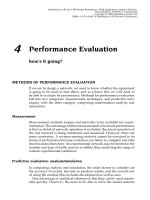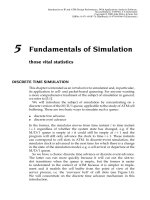Tài liệu Giới thiệu về IP và ATM - Thiết kế và hiệu suất P2 ppt
Bạn đang xem bản rút gọn của tài liệu. Xem và tải ngay bản đầy đủ của tài liệu tại đây (163.15 KB, 29 trang )
2
Traffic Issues and Solutions
short circuits, short packets
This chapter is the executive summary for the book: it provides a quick
way to find a range of analytical solutions for a variety of design and
performance issues relating to IP and ATM traffic problems. If you are
already familiar with performance evaluation and want a quick overview
of what the book has to offer, then read on. Otherwise, you’ll probably
find that it’s best to skip this chapter, and come back to it after you have
read the rest of the book – you’ll then be able to use this chapter as a
ready reference.
DELAY AND LOSS PERFORMANCE
In cell- or packet-based networks, the fundamental behaviour affecting
performance is the queueing experienced by cells/packets traversing the
buffers within those switches or routers on the path(s) from source to
destination through the network. This queueing behaviour means that
cells/packets experience variations in the delay through a buffer and
also, if that delay becomes too large, loss.
At its simplest, a buffer has a fixed service rate, a finite capacity
for the temporary storage of cells or packets awaiting service, and
a first-in–first-out (FIFO) service discipline. Even in this simple case,
the queueing behaviour depends on the type and mix of traffic being
multiplexed through the buffer. So let’s first look at the range of source
models covered in the book, and then we’ll summarize the queueing
analysis results.
Introduction to IP and ATM Design Performance: With Applications Analysis Software,
Second Edition. J M Pitts, J A Schormans
Copyright © 2000 John Wiley & Sons Ltd
ISBNs: 0-471-49187-X (Hardback); 0-470-84166-4 (Electronic)
16
TRAFFIC ISSUES AND SOLUTIONS
Source models
Model: negative exponential distribution
Use: inter-arrival times, service times, for cells, packets, bursts, flows, calls
Formula: Prfinter-arrival time tgDFt D 1 e
Ðt
Parameters: t –time
– rate of arrivals, or rate of service
Location: Chapter 6, page 83
Model: geometric distribution
Use: inter-arrival times, service times, for cells, packets, bursts, flows, calls
Formulas: Prfk time slots between arrivalsgD1 p
k1
Ð p
Prf k time slots between arrivalsgD1 1 p
k
Parameters: k – time slots
p – probability of an arrival, or end of service, in a time slot
Location: Chapter 6, page 85
Model: Poisson distribution
Use: number of arrivals or amount of work, for octets, cells, packets, bursts,
flows, calls
Formulas: Prfk arrivals in time TgD
Ð T
k
k!
Ð e
ÐT
Parameters: T –time
k – number of arrivals, or amount of work
– rate of arrivals
Location: Chapter 6, page 86
Model: binomial distribution
Use: number of arrivals (in time, or from a number of inputs) or amount of
work, for octets, cells, packets, bursts, flows, calls
Formula: Prfk arrivals in N time slotsgD
N!
N k! Ð k!
Ð 1 p
Nk
Ð p
k
Parameters: k – number of arrivals, or amount of work
p – probability of an arrival, in a time slot or from an input
N –numberoftimeslots,ornumberofinputs
Location: Chapter 6, page 86
DELAY AND LOSS PERFORMANCE
17
Model: Batch distribution
Use: number of arrivals, or amount of work, for octets, cells, packets,
bursts, flows, calls
Formulas: a0 D 1 p
a1 D p Ð b1
a2 D p Ð b2
.
.
.
ak D p Ð bk
.
.
.
aM D p Ð bM
Parameters: k – number of arrivals
p – probability there is a batch of arrivals in a time slot
bk – probability there are k arrivals in a batch (given that there is a
batch in a time slot)
M – maximum number of arrivals in batch
Location: Chapter 6, page 88
Model: ON–OFF two-state
Use: rate of arrivals, for octets, cells, packets
Formulas: T
on
D
1
R
Ð E[on]
T
off
D
1
C
Ð E[off]
Parameters: R – rate of arrivals
E[on] – mean number of arrivals in ON state
C – service rate, or rate of time-base
E[off] – mean number of time units in OFF state
Location: Chapter 6, page 91
Model: Pareto distribution
Use: number of arrivals, or amount of work, for octets, cells, packets, etc.
Formulas: PrfX > xgD
υ
x
˛
Fx D 1
υ
x
˛
f x D
˛
υ
Ð
υ
x
˛C1
E[x] D υ Ð
˛
˛ 1
(continued overleaf )
18
TRAFFIC ISSUES AND SOLUTIONS
Model: Pareto distribution
Parameters: υ – minimum amount of work
x –numberofarrivals,oramountofwork
˛ – power law decay
Location: Chapter 17, page 289
Queueing behaviour
There are a number of basic queueing relationships which are true,
regardless of the pattern of arrivals or of service, assuming that the buffer
capacity is infinite (or that the loss is very low). For the basic FIFO queue,
there is a wide range of queueing analyses that can be applied to both
IP and ATM, according to the multiplexing scenario. These queueing
relationships and analyses are summarized below.
Model: elementary relationships
Use: queues with infinite buffer capacity
Formulas: D Ð s
w D Ð t
w
(known as Little’s formula)
q D Ð t
q
(ditto)
t
q
D t
w
C s
q D w C
Parameters: – mean number of arrivals per unit time
s – mean service time for each customer
– utilization; fraction of time the server is busy
w – mean number of customers waiting to be served
t
w
– mean time a customer spends waiting for service
q – mean number of customers in the system (waiting or being
served)
t
q
– mean time a customer spends in the system
Location: Chapter 4, page 61
Model: M/M/1
Use: classical continuous-time queueing model; NB: assumes variable-
size customers, so more appropriate for IP, but has been used for
ATM
Formulas: q D
1
(continued)
DELAY AND LOSS PERFORMANCE
19
Model: M/M/1
t
w
D
Ð s
1
Prfsystem size D xgD1
x
Prfsystem size > xgD
xC1
Parameters: – utilization; load (as fraction of service rate) offered to system
q – mean number in the system (waiting or being served)
t
w
– mean time spent waiting for service
x – buffer capacity in packets or cells
Location: Chapter 4, page 62
Model: batch arrivals, deterministic service, infinite buffer capacity
Use: exact M/D/1, binomial/D/1, and arbitrary batch distributions –
these can be applied to ATM, and to IP (with fixed packet sizes)
Formulas: E[a] D
s0 D 1 E[a]
sk D
sk 1 s0 Ð ak 1
k1
iD1
si Ð ak i
a0
PrfU
d
D 1gDU
d
1 D s0 C s1
PrfU
d
D kgDU
d
k D sk
B
d
k D
1
k
iD0
ai
E[a]
T
d
k D
k
jD1
U
d
j Ð B
d
k j
T
d,n
k D
k
jD1
T
d,n1
j Ð T
d,1
k j
for M/D/1: t
w
D
Ð s
2 Ð 1
Parameters: ak – probability there are k arrivals in a time slot
– utilization; load (as fraction of service rate) offered to system
E[a] – mean number of arrivals per time slot
(continued overleaf )
20
TRAFFIC ISSUES AND SOLUTIONS
Model: batch arrivals, deterministic service, infinite buffer capacity
sk – probability there are k in the system at the end of any slot
U
d
k – probability there are k units of unfinished work in the buffer
B
d
k – probability there are k arrivals ahead in arriving batch
T
d
k – probability that an arrival experiences total delay of k
T
d,n
k – probability that total delay through n buffers is k
s – mean service time for each customer
t
w
– mean time spent waiting for service
Location: Chapter 7, pages 100, 109, 110; and Chapter 4, page 66 (M/D/1
waiting time)
Model: batch arrivals, deterministic service, finite buffer capacity
Use: exact M/D/1, binomial/D/1, and arbitrary batch distributions –
these can be applied to ATM, and to IP (with fixed packet sizes)
Formulas: Ak D 1 a0 a1 ÐÐÐak 1
u0 D 1
uk D
uk 1 ak 1
k1
iD1
ui Ð ak i
a0
uX D AX
s0 D
1
X
iD0
ui
sk D s0 Ð uk
CLP D
E[a] 1 s0
E[a]
Parameters: ak – probability there are k arrivals in a time slot
Ak – probability there are at least k arrivals in a time slot
E[a] – mean number of arrivals per time slot
sk – probability there are k cells in the system at the end of any slot
– utilization; load (as fraction of service rate) offered to system
CLP – probability of loss (whether cells or packets)
Location: Chapter 7, page 105
DELAY AND LOSS PERFORMANCE
21
Model: N·D/D/1
Use: multiple constant-bit-rate (CBR) sources into deterministic server –
this can be applied to ATM, and to IP (with fixed packet sizes)
Formulas: Qx D
N
nDxC1
N!
n! Ð N n!
Ð
n x
D
n
Ð
1
n x
D
Nn
Ð
D N C x
D n C x
Parameters: x – buffer capacity (in cells or packets)
N – number of CBR sources
D – period of CBR source (in service time slots)
Qx – probability that queue exceeds x (estimate for loss probability)
Location: Chapter 8, page 116
Model: M/D/1 heavy-traffic approximation
Use: cell-scale queueing in ATM, basic packet queueing in IP (with fixed
packet sizes); NB: below ³80% load, underestimates loss
Formulas: Qx D e
2ÐxÐ
1
x D
1
2
Ð lnQx Ð
1
D
2 Ð x
2 Ð x lnQx
Parameters: x – buffer capacity (in cells or packets)
– utilization; load (as fraction of service rate) offered to system
Qx – probability that queue exceeds x (estimate for loss probability)
Location: Chapter 8, page 117
Model: N·D/D/1 heavy-traffic approximation
Use: multiple constant-bit-rate (CBR) sources into deterministic server – this
can be applied to ATM, and to IP (with fixed packet sizes); NB: below
³80% load, underestimates performance
Formulas: Qx D e
2ÐxÐ
x
N
C
1
Parameters: x – buffer capacity (in cells or packets)
(continued overleaf )
22
TRAFFIC ISSUES AND SOLUTIONS
Model: N·D/D/1 heavy-traffic approximation
– utilization; load (as fraction of service rate) offered to system
N – number of CBR sources
Qx – probability that queue exceeds x (estimate for loss probability)
Location: Chapter 8, page 120
Model: Geo/Geo/1
Use: basic discrete-time queueing model for IP (variable-size packets)
Formulas: s0 D 1
p
q
sk D
1
p
q
Ð
p
1 q
Ð
1 q
1 p
k
Qk D
p
q
Ð
1 q
1 p
k
Qx D
p
q
Ð
1 q
1 p
x/q
Parameters: q – probability a packet completes service at the end of an octet slot
p – probability a packet arrives in an octet slot
sk – probability there are k octets in system
Qk – probability that queue exceeds k octets
Qx – probability that queue exceeds x packets
Location: Chapter 14, page 232
Model: excess-rate, Geometrically Approximated Poisson Process (GAPP),
M/D/1
Use: accurate approximation to M/D/1 – can be applied to ATM, and to
IP (with fixed packet sizes)
Formulas: pk D
1
Ð e
e
2
C C e
1 C e
Ð
Ð e
e
2
C C e
1 C e
k
Qk D
Ð e
e
2
C C e
1 C e
kC1
Parameters: – arrival rate of Poisson process
pk – probability an arriving excess-rate cell/packet finds k in the
system
(continued)
DELAY AND LOSS PERFORMANCE
23
Model: excess-rate, Geometrically Approximated Poisson Process (GAPP),
M/D/1
Qk – probability an arriving excess-rate cell/packet finds more than k
in the system
Location: Chapter 14, page 245
Model: excess-rate GAPP analysis for bi-modal service distributions
Use: accurate approximation to M/bi-modal/1 – suitable for IP, with
bi-modal distribution to model short and long packets
Formulas: E[a] D Ð p
s
C 1 p
s
Ð n
a0 D p
s
Ð e
C 1 p
s
Ð e
nÐ
a1 D p
s
Ð Ð e
C 1 p
s
Ð n Ð Ð e
nÐ
pk D
1
E[a] Ð 1 a1 1 C a1 C a0
2
a0 Ð E[a] 1 C a0
Ð
E[a] Ð 1 a1 1 C a1 C a0
2
a0 Ð E[a] 1 C a0
k
Qk D
E[a] Ð 1 a1 1 C a1 C a0
2
a0 Ð E[a] 1 C a0
kC1
Parameters: ak – probability there are k arrivals in a packet service time
E[a] – mean number of arrivals per packet service time
– packet arrival rate of Poisson process (i.e. per time unit D short
packet)
p
s
– proportion of short packets
n – length of long packets (multiple of short packet)
pk – probability an arriving excess-rate packet finds k in the system
Qk – probability an arriving excess-rate packet finds more than k
in the system
Location: Chapter 14, page 249
Model: excess-rate GAPP analysis for M/G/1
Use: accurate approximation to M/G/1 – suitable for IP, with general
service time distribution to model variable-length packets
(continued overleaf )
24
TRAFFIC ISSUES AND SOLUTIONS
Model: excess-rate GAPP analysis for M/G/1
Formulas: E[a] D Ð
1
iD1
gi D
a0 D
1
iD1
gi Ð e
iÐ
a1 D
1
iD1
gi Ð i Ð Ð e
iÐ
pk D
1
E[a] Ð 1 a1 1 C a1 C a0
2
a0 Ð E[a] 1 C a0
Ð
E[a] Ð 1 a1 1 C a1 C a0
2
a0 Ð E[a] 1 C a0
k
Qk D
E[a] Ð 1 a1 1 C a1 C a0
2
a0 Ð E[a] 1 C a0
kC1
Parameters: Ak – probability there are k arrivals in a packet service time
E[a] – mean number of arrivals per packet service time
– packet arrival rate of Poisson process (i.e. per unit time)
gk – probability a packet requires k units of time to be served
pk – probability an arriving excess-rate packet finds k in the system
Qk – probability an arriving excess-rate packet finds more than k in
the system
Location: Chapter 14, page 249
Model: ON–OFF/D/1/K
Use: basic continuous-time queueing model for IP or ATM, suitable for
per-flow or per-VC scenarios
Formulas: ˛ D
T
on
T
on
C T
off
CLP
excess-rate
D
C ˛ Ð R Ð e
XÐC˛ÐR
T
on
Ð1˛ÐRCÐC
1 ˛ Ð C ˛ Ð R C Ð e
XÐC˛ÐR
T
on
Ð1˛ÐRCÐC
CLP D
R C
R
Ð CLP
excess-rate
Parameters: R –ONrate
C – service rate of buffer
(continued)
DELAY AND LOSS PERFORMANCE
25
Model: ON–OFF/D/1/K
X – buffer capacity in cells/packets
T
on
–meandurationinONstate
T
off
–meandurationinOFFstate
˛ – activity factor of source (probability of being ON)
CLP – loss probability
Location: Chapter 9, page 130
Model: ON–OFF/D/1/K
Use: basic discrete-time queueing model for IP or ATM, suitable for per-flow
or per-VC scenarios
Formulas: a D 1
1
T
on
Ð R C
s D 1
1
T
off
Ð C
pX D
1
1 C
s
a
X
1
Ð
1 a
s a
CLP D
R C
R
Ð CLP
excess-rate
D
R C
R
Ð pX
Parameters: R –ONrate
C – service rate of buffer
X – buffer capacity in cells/packets
T
on
–meandurationinONstate
T
off
–meandurationinOFFstate
pk D probability an excess-rate arrival finds k in the buffer
CLP – loss probability
Location: Chapter 9, page 136
Model: multiple ON–OFF sources – bufferless analysis
Use: burst-scale loss model for IP or ATM – for delay-sensitive traffic,
or, combined with burst-scale delay analysis, for delay-insensitive
traffic
Formulas: ˛ D
m
h
D
T
on
T
on
C T
off
N
0
D
C
h
(continued overleaf )









